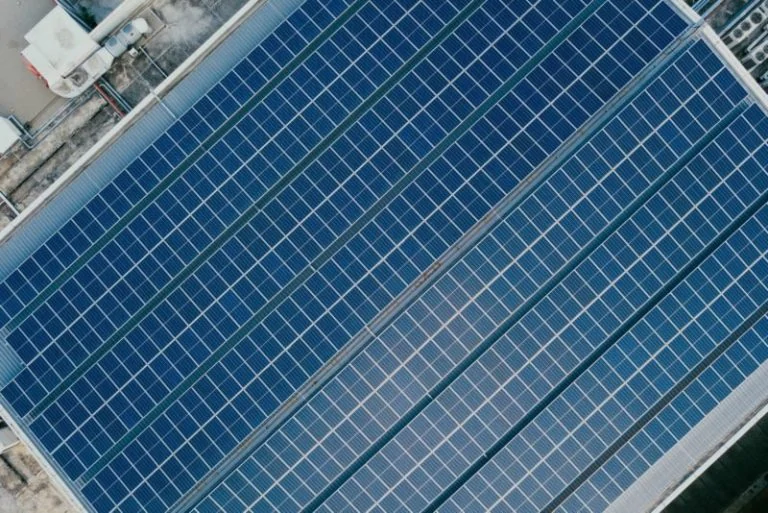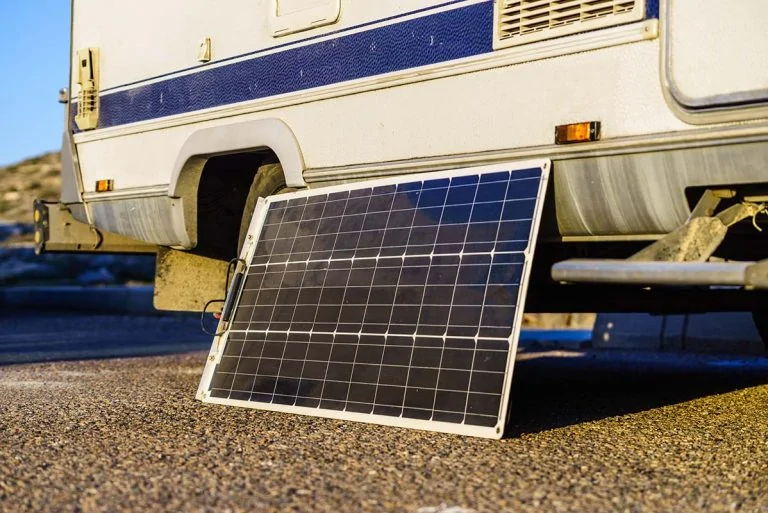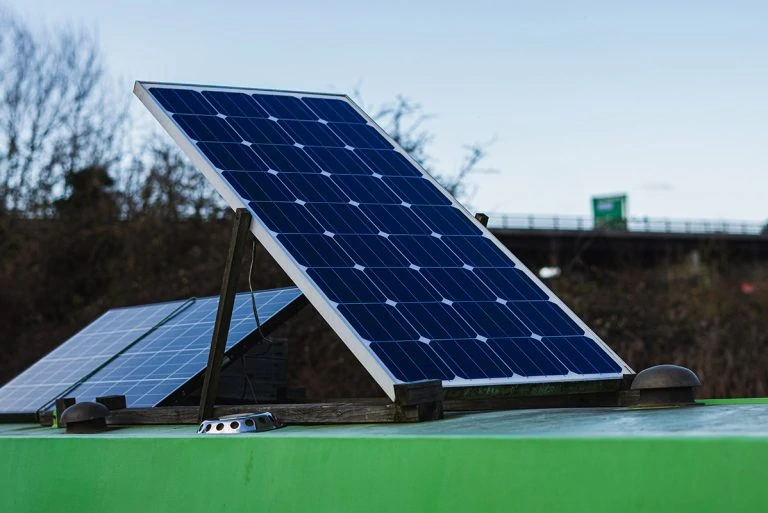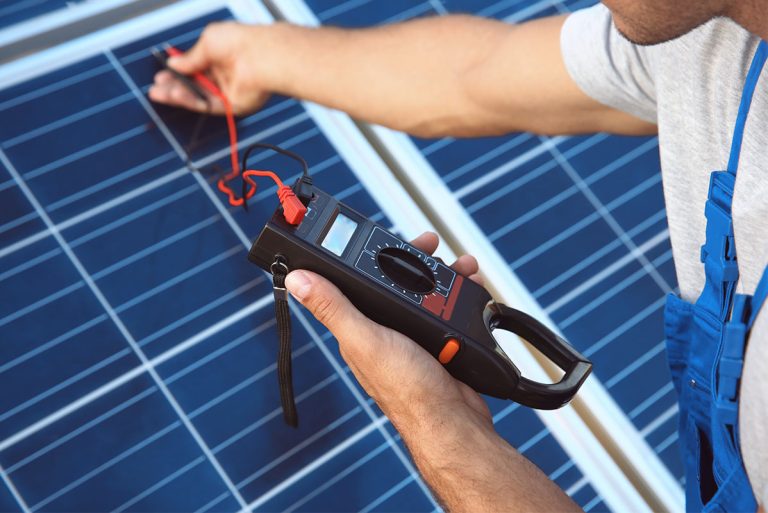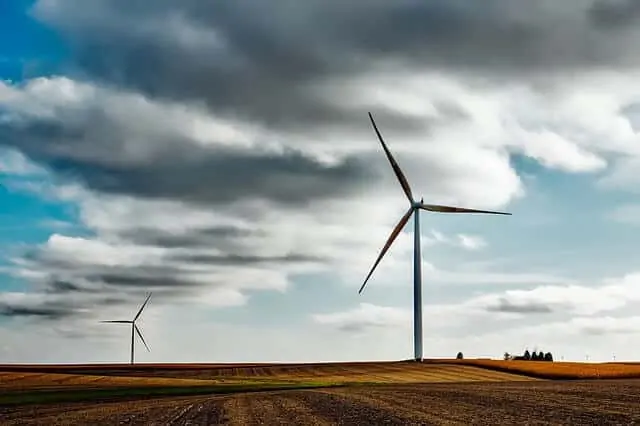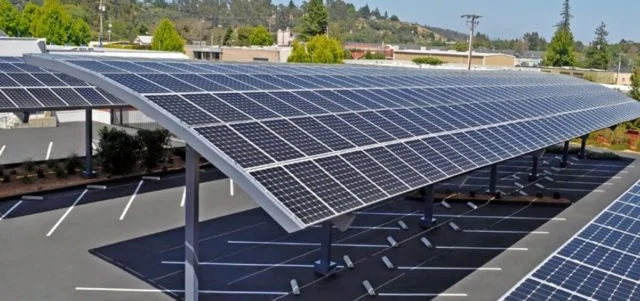Are you, like a growing number of homeowners, looking to save on home energy bills by going solar? You may be tempted to think bifacial solar panels would give you twice as much energy as traditional solar modules and translate into double the electricity savings.
Not so fast.
In this ultimate guide to bifacial solar panels, you’ll find out everything you need to know about these two-sided solar marvels.
With this knowledge, you’ll be able to make an informed decision about whether bifacial solar panels are right for you.
What are bifacial solar panels?
Bifacial (two-faced) solar panels (BSPs) are a type of photovoltaic (PV) module that captures solar energy on both its top and bottom sides. The front side facing the sun absorbs direct sunlight. The back end catches the direct rays falling around the panel and the diffuse sun rays, both of which are reflected off of the ground. The lighter the ground’s surface, the greater the reflection. This phenomenon is called the albedo.
Below is a schematic of a bifacial solar panel and how sun rays reach it:
By contrast, monofacial (one-faced) solar panels transform solar radiation into electrical energy from solar cells located on their top side only.
Since Bell Labs began experiments in 1954 followed by the first patented design in 1960 for a bifacial solar cell, BSPs have gained popularity only recently as part of the clean energy transition away from fossil fuels. It was the invention and commercialization of PERC cells in this century that substantially increased the efficiency of BSPs and led to their wider utilization. (More on PERC below.)
Today, BSPs are primarily used for utility-scale generation of solar energy. For example, one of the largest bifacial solar systems in the United States was built in Georgia in 2019. It supplies clean energy to 30,000 households.
How do bifacial solar cells capture light energy?
The top side of bifacial solar cells (BSCs) capture direct rays of light energy in the same way that monofacial solar cells do. However, the back end catches the reflected light energy that monofacial solar cells cannot absorb as well.
In conventional monofacial mono- and polycrystalline solar cells, some direct light energy goes through the solar cells. It is lost as heat. In theory, if there were another solar cell on the back, it could possibly absorb the lost energy before it dissipates as heat.
There is also direct light energy that arrives around the solar module and is bounced off of surrounding surfaces. Also, diffuse light on cloudy days is present. Monofacials may absorb some of these light forms.
Bifacial solar cells, on the other hand, specialize in capturing the reflected and diffuse light energy. They perform this feat most efficiently when that light is reflected off of a light-colored surface, (for example, a flat white roof or desert sand), and passes through the transparent back sheet or glass.
This is called the albedo effect. The light rays enter the rear-facing solar cells where their radiant energy can be converted into electricity.
What do bifacial solar panels look like?
Although there are many different types of bifacial solar cells that do the heavy lifting in converting the sun’s radiant energy to electrical energy, all bifacial solar panels look very much the same.
Generally, they are slimmer than their monofacial counterparts. In fact, they resemble thin film solar panels more than conventional, bulky mono- or polycrystalline solar panels set in metal frames.
However, bifacial solar panels are usually heavier than mono- and polycrystalline monofacial solar modules because they often have tempered glass on both sides rather than just on the front side. A clear back sheet may be substituted for the glass in some panels.
BSPs are usually heavier even if they are frameless which many are. By comparison, monofacial modules are always encased in metal frames and have a solid metallic backing that prevents light from entering through the underside.
What is the major difference between monofacial and bifacial solar panels?
The major difference between bifacial and monofacial solar panels is that BSPs do not have a solid metal back like monofacial panels have. Instead, they rely on a metallic screen (grid) printed on the silicon wafer for electrical conduction.
Traditional monofacials with a solid metal backing have aluminum back surface field solar cells referred to as Al-BSF. Al is the chemical symbol for aluminum. You will see both of these shorthand names in some of the diagrams in this article.
Instead of a solid metal sheet, bifacials are made with a highly conductive, although expensive, silver paste for electrical transmission. Silver is noted by its chemical symbol, Ag, in many solar cell diagrams in this article.
How are bifacial solar panels made?
Crystalline silicon (c-Si) bifacial solar panels (BSPs) are made just like traditional mono- and polycrystalline monofacial solar panels are constructed with the addition of two extra steps. These additional steps are required to preserve the solar cells’ efficiency and protect the solar cells on the bottom side.
In her doctoral dissertation on BSPs, Claudia Duran summarizes the manufacturing similarities and differences between crystalline silicon bifacial and monofacial p-type wafers in a table reproduced below:
The second step in BSP formation involves the doping of silicon wafers with boron (BBr3) done in a very precise manner. The third step is needed to prevent the recombining of energized electrons back into PV material before they form electrical current and move in an organized stream out of the solar cells and into your home.
Other types of bifacial solar cells are manufactured differently. The section below presents some key distinguishing features of these processes.
What are the 5 types of bifacial solar panels?
There are five major types of bifacial solar panels (BSPs) on the market today. They differ in the type of solar cell used.
Monofacial solar modules may also employ these cell types. A plus (+) sign after the cell’s acronym is sometimes used to denote a bifacial solar cell.
- Passivated emitter and rear cell or contact (PERC)
- Passivated emitter rear totally diffused (PERT)
- Passivated emitter rear locally diffused (PERL)
- Silicon heterojunction with multiple intrinsic thin layers (HIT)
- Interdigitated Back Contact (IBC)
According to industry analysts, the most common type of BSP employed today is PERT. HIT is in second place followed by PERC+.
1. PERC solar cells
PERC solar cells currently dominate the PV industry, replacing the traditional aluminum back surface field solar cells (Al-BSF).
The graph below summarizes the shift in cell types across the PV industry.
All PERC and PERC+ solar cells feature passivation and dielectric capping layers that conventional mono- and polycrystalline Al-BSF solar cells do not have. You can see them in the diagram below of a side view of a PERC solar module:
The passivation and dielectric capping layers consisting of various high-quality metal oxides prevent surface recombination of electron-hole pairs. This means instead of rejoining and merging back into the PV material of the cell, energized electrons separate and move in an organized fashion forming the electrical current that starts its journey into your home.
Here’s a schematic showing PERC and PERC+ side by side:
Fortunately, the manufacture of PERC+ in factories which already make PERC cells is possible. Practically no modification of the production line from PERC to PERC+ is needed. Just a change of the screen-printed grid layout is required.
2. PERL solar cells
PERL, as well as PERT, solar cells are improvements on PERC cell technology but very similar in design and manufacture. They have been shown in laboratory tests to achieve up to 25% efficiency. Incidentally, recycled silicon used in PERC cells can reach almost 20% efficiency.
In PERL, electron-hole recombination in the rear is reduced by diffused boron or phosphorus doping only at the metal contact points. This means freed electrons don’t easily return to the PV materials in the cell.
Rather, they become part of the electric current that feeds the electrical devices and appliances in your home.
3. PERT solar cells
In PERT, boron or phosphorus diffusion occurs throughout the back surface.
PERT is a popular choice for bifacial solar cells because it undergoes very little light-induced degradation (LID) unlike PERC cells.
4. Heterojunction with multiple intrinsic thin layers (HIT)
Heterojunction (HJT) solar cells feature a layer of crystalline silicon (c-Si) sandwiched between two layers of amorphous silicon (a-Si). HIT cells have many more ultra-thin a-Si layers than HJT cells.
Here is a schematic of a HJT solar panel side view clearly showing the a-Si layers:
For comparison, here is a diagram of a HIT solar cell. TCO in the diagram stands for transparent conductive oxide. TCO could be any number of metal oxides that play an important role in electrical conduction.
HJT and HIT cells enjoy extremely low temperature coefficients (~0.26%/°C). They are highly efficient as well (24%+). Plus, they are easier to manufacture than conventional mono- and polycrystalline solar cells. The process is simpler and also less energy intensive.
HIT cells are perfectly suited for bifacial applications because the rear cell efficiency approximates the front cell efficiency. In other words, the back cell can convert as much solar energy to electrical energy as the front cell under the right conditions!
The ratio between the rear and front power outputs (sometimes efficiencies are used in the mathematical formulas) is known as the bifaciality factor. See below for more on this.
For HIT cells, the bifaciality factor is 92-100% with optimization. In PERC+ cells, by contrast, the bifaciality factor may hover around 65-80%. This means the bottom solar cell produces only 65-80% of the power generated by the top solar cell.
What is the bifaciality factor? [A sample calculation using the bifaciality factor]
The bifaciality factor, B, is a metric used to quantify how well the back solar cells in a bifacial solar panel perform compared to the front solar cells.
Mathematically, B is a ratio of the maximum power points (as displayed on the I-V curve) for both rear and front cells at standard test conditions. The bifaciality factor is often expressed as a percentage.
B = [Pmpp, rear /Pmpp, front] x 100
Prospective buyers interested in using the bifaciality factor to calculate the maximum power output from the rear side of a bifacial solar panel may be able to do so using numbers from panel specification sheets.
Each company presents their panels’ specs differently, and all the data you need may not be there. The bifaciality factor may not be given. When in doubt, call the company for more information.
As an example, Hanwha bifacial Q.ANTUM cells spec sheets list the bifaciality factor as 70% +/- 5% under standard test conditions (STC). So, using the Pmpp of the front panel given in the specs as 470W, the Pmpp, rear must be (when you rearrange the equation above):
Pmpp, rear = B x Pmpp, front = 0.70 x 470 = 329W
However, the Pmpp for the entire bifacial solar panel — in the column called BSTC on the spec sheet — is 514W. It is not, as you may expect if the maximum powers were additive: 470W + 329W = 799W.
In the real world, the tilt angle of the solar array, height off the ground, altitude, and albedo largely determine how much power the bifacial solar module as a single functional unit will actually produce.
Other factors, such as shading, soiling, and the many types of panel degradation, also influence the final number.
When sizing your solar system using bifacial solar panels, some companies, like Prism Solar, will indicate directly on the spec sheet that you should use the BSTC value of the maximum power point, not the value listed for the front side only to determine how many panels you need to meet your household energy demands.
5. Interdigitated Back Contact (IBC)
In IBC (rear contact) solar cells, the metal contacts (electrodes) through which electrical current passes are placed entirely on the back of the module. This placement eliminates energy losses due to shading on the front cell.
The difference amounts to a 5-7% gain in electrical current, leaving IBC cells vs. cells with front-facing electrodes.
Through this arrangement of conducting wires in IBC solar cells, the front side has the fewest obstacles to light absorption. All electrical conduction and energy conversions occur on the module back.
What is the preferred metal used in bifacial solar panels?
In PERC+/PERL/PERT bifacials, silver is still the most preferred metal to use. It is highly conductive.
Although there has been a significant reduction in the amount of aluminum in PERC+ compared to PERC solar cells — from 1.0g to 0.2g per silicon wafer — this is not the case for silver.
Researchers are working on finding cheaper silver substitutes for efficient electrical passage in solar cells, especially since the cost of silver has increased substantially in recent years. Silicon heterojunction cells in particular hold much promise in maintaining high efficiency with less expensive metals.
Along with silver, the scarcity of other metals significantly contributes to the cost of solar panels. Monofacials of all cell types also use silver, so the problem of silver metal scarcity is PV industry-wide.
How common are bifacial solar modules in the solar industry?
According to The International Technology Roadmap for Photovoltaic (ITRPV), in 2020, bifacial solar cells made up 20% of the solar cell market. Experts predict that by 2030, market share will increase to 70%.
However, the actual and predicted market shares for bifacial solar panels (BSPs) are not as remarkable for the same time period. In 2020, a mere 12% of the solar panel market belonged to BSPs. The percentage is expected to climb to only 30% by 2030.
So the logical question about the apparent incongruence between these numbers is: What’s going to happen to all the bifacial solar cells that will be manufactured by 2030 if they won’t be in bifacial solar modules?
Solar industry analysts predict that bifacial solar cells will become incorporated in monofacial modules constructed with special features.
White back encapsulant or reflective back sheets in these modules will enhance the modules’ power ratings. In effect, modules constructed in this manner are like bifacial-monofacial hybrids.
It remains to be seen how these modules will be priced or what they will be called. Keep your eye on this space for updates on bifacial-monofacial solar panel hybrids.
Are bifacial solar panels more expensive than monofacial solar panels?
It is commonly believed that bifacial solar panels (BSPs) are significantly more expensive than their monofacial counterparts. This was true before PERC cells became mass produced in the mid-2010s, but it is no longer true today.
The National Renewable Energy Lab (NREL) released a price-per-watt cost comparison between monofacial and bifacial solar panels in 2019. Some types of BSPs have achieved price parity with monofacials — or are very close to it — as the graph below illustrates:
Are bifacial solar panels twice as efficient as monofacial solar panels?
In general, bifacial solar panels (BSPs) are not twice as efficient as monofacial solar panels in converting solar energy to electrical energy except possibly in lab settings using certain types of bifacial solar cells.
Today, PERC cells in monofacial solar modules afford an approximate 22.5% efficiency. This is the practical upper limit for mono PERC modules.
However, in a BSP PERC (noted as PERC+) module, overall efficiencies 11% greater than monofacial counterparts are possible according to studies by LONGi, a major solar manufacturer.
For example, if that study is accurate, a bifacial solar panel with the same type and number of solar cells, tested under the same operating conditions and positioned in the same way as its monofacial counterpart that has a 20% efficiency, will have an efficiency of 20 + 11 = 31%.
How much is the energy boost of a bifacial solar panel?
The “energy boost” of a bifacial solar panel (BSP) compared to its monofacial counterpart refers to the additional energy yield afforded by the bottom side of bifacial PV modules. It tells you how much more power output you can expect from BSPs compared to monofacial PV modules of the same power rating (ex., 370W) set up in an identical manner.
A 1982 study by Cuevas, et al., found that the energy boost of a BSP compared to a monofacial module just like it under the same operating conditions was 50%. For that study, the research team used special light concentrating systems that most people wouldn’t have access to or couldn’t afford.
More recent research shows that with an expensive solar tracking system, 27% energy yield increases are possible.
On various bifacial panel spec sheets we reviewed for this article, the energy boost from BSPs varied between 20-35%. However, and not to throw shade (no pun intended) on your high hopes for BSPs, other research shows energy gains of 3-10% are more realistic.
What determines the energy boost of bifacial solar panels?
Several factors determine exactly how much energy boost BSPs will deliver. Researchers working for the solar company Solar World AG have identified two factors as the most important:
- The albedo of the surface under the modules
- The height of the bottom panel in relation to that surface.
The team developed a complex mathematical formula to determine the additional energy gain from bifacials. Here it is:
Key to formula:
a = 1.037
A = row pitch between the modules
E = 2.718
B = 8.691
H = distance between the lowest point on the module
frame and the roof or ground
c = 0.125
Using the formula, they generated the following data displayed graphically below:
The researchers concluded that the surface with the highest reflective capacity (albedo) located approximately 18 in. (0.5 meter) below the bottom of the lowest panel row yielded the greatest energy boost.
Other solar companies recommend heights of at least 1 meter (36 in.) The ideal height according to their research is 1.2-1.3m (47-51 in.)
Installing bifacial solar panels
If you’re considering bifacial solar panels for your home as the major source of energy to meet all of your family’s needs, it only makes economic sense if you have plenty of space for a ground mount system (to avoid row shading) in an area with a very high albedo at a high latitude.
Latitude and bifacial solar panels
Here’s a graph of data showing why 60° or higher latitude is best for optimal energy yield gain in bifacials with or without solar tracking compared to monofacials:
Another source comes to the same conclusion: 60° or higher latitude is optimal for BSPs.
Albedo and bifacial solar panels
Albedo varies widely among surface types. Here’s a table that quantifies albedo under standard test conditions:
Ideally, for a small solar array serving one home, an albedo of at least 50% is needed to make BSPs cost-effective.
By contrast, an albedo of 25%, common with vegetation or soil, results in a relative energy gain (compared to monofacials) of only 10%.
Note that albedo changes throughout the day and with the seasons. Some surfaces may receive reduced albedo over time due to weathering or soiling. When crunching the numbers to determine power output and how long your economic payback period or energy payback period will be, it’s important to take a changing albedo into account.
Ground cover ratio and bifacial solar panels
A metric used to quantify the needed space between panel rows to avoid shading is called the ground cover ratio (GCR). This is the ratio between the area occupied by the panels and the total available area. Studies show that 40-50% is the optimal GCR for a ground mounted bifacial solar system.
Are bifacial solar panels for homes worth it?
For most homes, bifacial solar panels (BSPs) to meet all of your energy needs are not recommended. However, there are a few situations where BSPs would do well.
People living in snowy regions at or above 60° latitude with lots of land — Alaskans, this means you! — could make bifacial solar panels work for them if the panels are:
1. Installed vertically — portrait style — to shed snow and expose more of the panels quickly or tilted correctly for your region
2. Spaced far enough apart to prevent shading of one row on another
3. Lowest panel is 18 in. minimum up to 51 in. from the ground
4. Facing the east and west to get two power peaks per day (sun rising and sun setting).
Similarly, people residing in high-latitude or subtropical deserts could benefit from BSPs.
Urbanites living in buildings with reflective roofs in sunny places could also take advantage of higher albedo. A California project mapping out potentials for “cool roofs” in a number of cities showed it was possible.
Vertically-mounted BSPs would enhance green roofs, too, in urban scenarios.
This is no joke: observe the temperature differences on white vs. black surfaces.
In all these uses of small-scale BSP, the modules are tilted or vertical. They are never mounted flush to a rooftop, even if the roof has a high albedo. On a roof, there is not enough space for reflection followed by absorption of radiant energy by the rear solar cells unless the entire array is elevated.
However, due to wind gales that could whip off the array and send it flying, it is not a good idea to mount the panels so far off of the roof.
If homeowners would like to use BSP on their property, but only as a supplement to a rooftop array of traditional monofacial panels, bifacials could produce some energy if they are horizontally positioned in:
- Carports
- Canopies
- Pergolas
- Patios
- Awnings
- Balconies
- Deck coverings
Can bifacial solar panel canopies perform well in cities?
There is growing evidence from real-life examples that bifacial solar panels (BSPs) on canopies in urban settings can perform well. Brooklyn, NY-based Urban Energy recently completed its first BSP canopy in New York City. The 46 kW system consists of 118 BSPs rated at 390W each placed atop a low-and-moderate-income multifamily building.
The company states the shading factor was minimal on the canopy compared to other rooftop solar systems in the city. Other advantages of the bifacial canopy vs. standard rooftop solar in a metropolitan location include:
- Maximizes solar power output in a confined space
- Adheres better to building codes (no obstruction or fire lane intrusion)
- Integrates well with battery storage and heat pumps
Urban Energy plans expansion to other NYC sites in 2023 with more planned for Chicago and Washington, D.C. in 2024.
Advantages and disadvantages of bifacial solar panels
Here’s a summary table of the major advantages and disadvantages of bifacial solar panels for homeowners considering them for a residential solar system. Most of these points have been discussed in this article, but a few are seen here for the first time.
| Advantages | Disadvantages |
| Makes use of both panel sides for energy capture | Not suited for rooftops |
| Provides an energy boost, increasing panel power output | Optimal power performance only in a few areas (high altitude and albedo over a large land area) |
| Adds to total panel efficiency | Uses specialized mounting hardware to limit shadows |
| Double glass panels (increased durability; some brands) | |
| Better at collecting diffuse solar rays | |
| Slower degradation (some cell types) | |
| Extended warranty (some brands) | |
| Exempt from tariffs | |
| Price parity with monofacials (some types) |
Key takeaways on bifacial solar panels
Bifacial solar panels (BSPs) have grown in popularity in recent years. Unlike monofacial solar panels which produce energy on just one side, both the front and back sides of BSPs convert solar energy into electricity.
Given today’s technology, BSPs can achieve — under ideal conditions — a 25-30% increase in power output compared to monofacial solar modules. Realistically speaking, 3-10% is more likely.
Some BSPs are slightly more expensive than their monofacial counterparts due to advanced technology and more specialized mounting hardware. However, costs are decreasing as BSPs become more common. Today, certain types are cost-competitive with monofacials.
Although bifacials are used on industrial and utility scales today, homeowners have fewer options regarding small-scale bifacial solar systems if they wish to save money on energy bills and enjoy a short payback period.
BSPs are not recommended for residential rooftop solar. There isn’t enough space for light to reach the bottom solar cells. However, if you have land for a well-spaced ground mount solar setup, bifacial solar panels could work. High altitude and high albedo are necessary for good solar power generation.
If you’re not able to support any kind of solar system on your property, participating in community solar programs may be an alternative way to get involved in the renewable energy transition while receiving energy cost savings.
